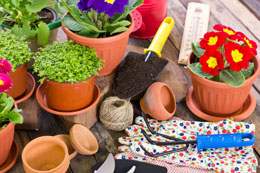Container gardening is particularly useful for those who have limited space to pursue their hobby of gardening. The following article contains tips, which will guide you in creating a flourishing container garden.

If you are one of those people who has a green thumb, and loves gardening, but cannot fulfill your hobbies because of a lack of space, then container gardening is just for you. It is particularly popular among urban residents, who find it difficult to tend to their hobby of gardening. Container gardens literally refer to growing a variety of plants in a pot, and placing them wherever convenient, even on your window sill.
Tips
Garden Location
Determine the space you have available to design your own container garden. If it is by a window sill, you will have to choose plants and containers accordingly. However, if you have a larger space such as a balcony, you may put together a collection of smaller and larger pots, in a manner that is aesthetically pleasing.
Choosing the Right Containers
To begin with, the container that you choose for your garden, should primarily have drainage holes. This is to rid the soil of excess water. If the drainage holes are absent, it leads to water logging, that will damage both, the soil as well as the plant. The style is secondary. In case you live in cold climatic conditions, choose slightly larger pots as soil expands in cooler climates. Also, the size of the pot depends on the kind of plant you wish to grow in it. If it is a small tree or a shrub, the pot should be heavy enough to hold the weight. The colors and the style will depend on the kind of theme you are setting up for your garden. Break free from the regular terracotta pots and urns.
Choosing the Right Plants
The type of plants and the choice of containers go hand in hand. So, if you choose to keep colorful flowering plants, then ensure that the color of your pots and plants do not clash with each other. As mentioned earlier, the entire setup should be arranged in a manner that is visually appealing. As such, deciding the type of plant you wish to grow, in combination with the choice of pots, will help you achieve best results. Another consideration to keep in mind while choosing plants to be potted, is choosing those that will thrive in the climatic conditions that prevail in your area of residence. Some plants thrive better in dry areas, while others do well in tropical areas. These are some plants depending on seasonal variations.
Season
Choice of Plants
SpringBloomers: Primrose, Ferns, Pansies, Fritillaries, Kalanchoe
Flowering Shrubs: Azalea, Lilac, Rhododendron
Vegetables: Lettuce, Parsley, Radish
Bulbs that have been planted in the previous Fall
SummerHerbs, Roses, and other Decorative Grasses
Flowers: Wave Petunias, Larkspur, Marigolds, Abutilon, Coleus, Dahlia, Fuchsia, Bacopa, Herbs, Geranium, Scabiosa, Nasturtiums, Oxalis
Vegetables: Squash, Tomatoes, Beans, Cucumbers, Eggplant, Pepper
FallBegonias, Fuchsias, Impatiens
Bloomers: Marguerite Daisies, Mums, Gentian, Heather, Asters, Cyclamen, Heuchera, Osteospermum
Berries: Pyracanthas, Cotoneasters
WinterBoxwood, Wintergreen, Juniper, Privet
Laying the Soil
While planting the container, choose the right type of soil suitable for the plant. This information will be given to you by the nursery you pick up the plant from. Since the container you are planning to grow the plant in will become heavier after you have laid the soil, ensure that you do so in the chosen location for the plants. To lay the soil, first line the base of the pot with small rocks or wood chips. This is to prevent the loss of soil through drainage holes. Then lay the soil and add in the fertilizer. Fill up the container to a suitable level, up to which you wish the roots of the plant to rest. Then place the roots of the plant you wish to grow. Cover up the rest of the pot with soil, up to one inch below the rim of the pot. After you have finished, water the plant thoroughly. Sprinkle the top soil with pebbles, wood chips, or dried moss, to prevent the soil from drying.
Care and Maintenance
Now, maintaining a container garden is simple, though the watering and fertilizing requirements are slightly higher. These are the only and most important caring considerations to be kept in mind while olating such a garden. As mentioned before, in such gardens, the soil is prone to drying out quickly. Thus, it needs to be watered more often. During summer, water the plants early in the morning, and later in the evening. This will prevent evaporation. Also, remember to fertilize the plants on a regular basis, with the use of a good fertilizer. These methods will help you create and maintain a garden just like the one you desire.
Container gardening is a versatile form of gardening, as not only is it aesthetically appealing, but also easy to maintain and care for. It also fits in well, from a wide open landscape to your very own kitchen window sill. Use these tips and enjoy your most desired hobby.






 If you are one of those people who has a green thumb, and loves gardening, but cannot fulfill your hobbies because of a lack of space, then container gardening is just for you. It is particularly popular among urban residents, who find it difficult to tend to their hobby of gardening. Container gardens literally refer to growing a variety of plants in a pot, and placing them wherever convenient, even on your window sill.
If you are one of those people who has a green thumb, and loves gardening, but cannot fulfill your hobbies because of a lack of space, then container gardening is just for you. It is particularly popular among urban residents, who find it difficult to tend to their hobby of gardening. Container gardens literally refer to growing a variety of plants in a pot, and placing them wherever convenient, even on your window sill.